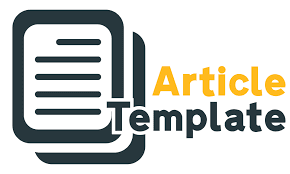Evaluasi Kemampuan Berpikir Kritis dan Self-efficacy Mahasiswa dalam Scientific Writing Hasil Pengamatan Ekologi
Sari
Teks Lengkap:
Hal. 154-162 (Download PDF)Referensi
Burress, T. (2022). Data Literacy Practices of Students Conducting Undergraduate Research. College and Research Libraries, 83(3), 434–451. https://doi.org/10.5860/crl.83.3.434
Clabough, E. B. D., & Clabough, S. W. (2016). Using rubrics as a scientific writing instructional method in early stage undergraduate neuroscience study. Journal of Undergraduate Neuroscience Education, 15(1), A85–A93.
Dissen, A. (2023). A critical issue: assessing the critical thinking skills and dispositions of undergraduate health science students. Discover Education, 2(1). https://doi.org/10.1007/s44217-023-00044-z
Dowd, J. E., Thompson, R. J., Schiff, L. A., & Reynolds, J. A. (2018). Understanding the complex relationship between critical thinking and science reasoning among undergraduate thesis writers. CBE Life Sciences Education, 17(1). https://doi.org/10.1187/cbe.17-03-0052
Erkol, M., Kişoǧlu, M., & Büyükkasap, E. (2010). The effect of implementation of science writing heuristic on students’ achievement and attitudes toward laboratory in introductory physics laboratory. Procedia - Social and Behavioral Sciences, 2(2), 2310–2314. https://doi.org/10.1016/j.sbspro.2010.03.327
Fleischner, T. L., Espinoza, R. E., Gerrish, G. A., Greene, H. W., Kimmerer, R. W., Lacey, E. A., & Pace, S. (2017). Teaching biology in the field: importance, challenges, and solutions. Biosciences, 67(6), 558–567.
Horanska, T. V., Bakumenko, T. K., Polishchuk, V. L., Atamanchuk, I. M., & Turchyn, T. M. (2022). Development of Students’ Verbal and Logical Thinking in the Course of Research Work. Journal of Curriculum and Teaching, 11(1), 185–194. https://doi.org/10.5430/jct.v11n1p185
Lai, E. R. (2011). Critical thinking: a literature review. Pearson’s Reserach Reports, 40–41.
Mantai, L., Swain, C., Bearman, M., & Brew, A. (2024). Assessment of student learning in undergraduate research engagement. Higher Education Research and Development, 43(4), 937–951. https://doi.org/10.1080/07294360.2023.2218808
Massimelli, J., Denaro, K., Sato, B., Kadandale, P., & Boury, N. (2019). Just Figures: A Method to Introduce Students to Data Analysis One Figure at a Time. Journal of Microbiology & Biology Education, 20(2). https://doi.org/10.1128/jmbe..v20i2.1690
Reynders, G., Lantz, J., Ruder, S. M., Stanford, C. L., & Cole, R. S. (2020). Rubrics to assess critical thinking and information processing in undergraduate STEM courses. International Journal of STEM Education, 7(1). https://doi.org/10.1186/s40594-020-00208-5
Reynolds, J. A., Thaiss, C., Katkin, W., & Thompson, R. J. (2012). Writing-to-learn in undergraduate science education: A community-based, conceptually driven approach. CBE Life Sciences Education, 11(1), 17–25. https://doi.org/10.1187/cbe.11-08-0064
Smith, K. G., & Paradise, C. J. (2022). Teaching the process of science with primary literature: Using the CREATE pedagogy in ecological courses. Ecology and Evolution, 12(12), 1–15. https://doi.org/10.1002/ece3.9644
Stephenson, N. S., & Sadler-Mcknight, N. P. (2016). Developing critical thinking skills using the Science Writing Heuristic in the chemistry laboratory. Chemistry Education Research and Practice, 17(1), 72–79. https://doi.org/10.1039/c5rp00102a
Treibergs, K. A., Esparza, D., Yamazaki, J. A., Goebel, M., & Smith, M. K. (2022). How do introductory field biology students feel? Journal reflections provide insight into student affect. Ecology and Evolution, 12(11), 1–20. https://doi.org/10.1002/ece3.9454
Treibergs, K. A., Esparza, D., Yamazaki, J. A., & Smith, M. K. (2023). Journal reflections shed light on challenges students face in an introductory field biology course. Ecosphere, 14(4), 1–14. https://doi.org/10.1002/ecs2.4509
Valliere, J. M. (2022). Cultivating scientific literacy and a sense of place through course-based urban ecology research. Ecology and Evolution, 12(6), 1–17. https://doi.org/10.1002/ece3.8985
Wahyuningrum, A. S. (2021). Analisis Kesalahan Mahasiswa dalam Menyajikan Representasi Visual Data Statistik pada Mata Kuliah Biostatistika. EduBiologia: Biological Science and Education Journal, 1(1), 30. https://doi.org/10.30998/edubiologia.v1i1.8083
Wijarini, F. (2024). Keterampilan Penelitian Mahasiswa Melalui Pembelajaran Berbasis Proyek Mini Research. Research and Development Journal of Education, 10(1), 118. https://doi.org/10.30998/rdje.v10i1.20746
Zou, T. X. P., Susanto, J., Wahab, A. A., Hong, N., Chiu, C. S. T., & Leung, L. Y. Y. (2022). What made undergraduate reserach experiences significant: A collaborative critical analysis with student co-reserachers. Higher Education Research and Development, 1–16.
Refbacks
- Saat ini tidak ada refbacks.








